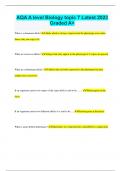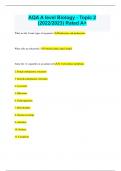BrainyPapers
Welcome to BrainyPapers Your destination for premium study documents that ignite your academic journey. Dive into a treasure trove of meticulously crafted notes, guides, and resources to ace your exams and excel in your studies.
- 849
- 0
- 19
Community
- Followers
- Following
869 items

AQA A-Level Biology - Topic 3 (2023/2024) with Verified Answers
Smaller organisms have a ........... surface area to volume ratio Higher How do single called organisms exchange substances? Diffuse directly into or out of the cell across the cell surface membrane Give 2 reasons why in multicellular organisms, diffusion across outer membrane would be too slow? 1. Some cells deep within body- big distance between them and outside 2. Larger animals have low surface area to volume ratio- difficult to exchange enough substances to supply large volume What 2...
- Package deal
- Exam (elaborations)
- • 23 pages •
Smaller organisms have a ........... surface area to volume ratio Higher How do single called organisms exchange substances? Diffuse directly into or out of the cell across the cell surface membrane Give 2 reasons why in multicellular organisms, diffusion across outer membrane would be too slow? 1. Some cells deep within body- big distance between them and outside 2. Larger animals have low surface area to volume ratio- difficult to exchange enough substances to supply large volume What 2...

AQA A-level Biology - Topic 4 Already Passed
Define variation Differences that exist between individuals In what ways can variation be caused? It can be caused by genetic factors, such as alleles from mutations. It can also be caused by the environment, such as climate. Most variation is caused by a combination of genetic factors and environmental factors Why is it impossible to study a whole population? Because it is too large and would take too long. Instead, scientists use a sample that is representative of the species' populatio...
- Package deal
- Exam (elaborations)
- • 34 pages •
Define variation Differences that exist between individuals In what ways can variation be caused? It can be caused by genetic factors, such as alleles from mutations. It can also be caused by the environment, such as climate. Most variation is caused by a combination of genetic factors and environmental factors Why is it impossible to study a whole population? Because it is too large and would take too long. Instead, scientists use a sample that is representative of the species' populatio...

AQA A-Level Biology – Proteins 2024
Amino Acid A monomer that will join with other amino acids to form a protein Dipeptide Two amino acids bonded together via a peptide bond Polypeptide Many amino acids bonded together via peptide bonds Protein A combination of polypeptides Amine Group -NH2, a basic group where the amino part of amino acid comes from Carboxyl Group -COOH, an acidic group where the acid part of amino acid comes from R Group A side group that can be comprised of different chemical groups Condensation Reaction...
- Package deal
- Exam (elaborations)
- • 4 pages •
Amino Acid A monomer that will join with other amino acids to form a protein Dipeptide Two amino acids bonded together via a peptide bond Polypeptide Many amino acids bonded together via peptide bonds Protein A combination of polypeptides Amine Group -NH2, a basic group where the amino part of amino acid comes from Carboxyl Group -COOH, an acidic group where the acid part of amino acid comes from R Group A side group that can be comprised of different chemical groups Condensation Reaction...

AQA A-Level Biology (new spec) Unit 1A - Biological Molecules Latest 2023 Graded A+
Monomers Small basic molecular units Examples of monomers monosaccharides, amino acids and nucleotides Polymers Large complex molecules composed of long chains of monomers joined together Examples of polymers Carbohydrates, proteins and nucleic acids What type of sugar is glucose? Hexose How many types of glucose are there? 2 What are the names of the types of glucose? Alpha-glucose and beta-glucose
- Package deal
- Exam (elaborations)
- • 13 pages •
Monomers Small basic molecular units Examples of monomers monosaccharides, amino acids and nucleotides Polymers Large complex molecules composed of long chains of monomers joined together Examples of polymers Carbohydrates, proteins and nucleic acids What type of sugar is glucose? Hexose How many types of glucose are there? 2 What are the names of the types of glucose? Alpha-glucose and beta-glucose

AQA A-Level Biology Topic 1: Biological Molecules (2022/2023) Already Passed
What are monomers? Monomers are *small units* which are the components of larger molecules. What are polymers? Polymers are molecules made from *many monomers* joined together. What are examples of monomers? *Monosaccharides, amino acids* and *nucleotides* What are examples of polymers? *Polysaccharides, polypeptides* and *polynucleotides* What reaction allows two monomers to bond together? A *condensation reaction* allows *two monomers* to be joined together by a chemical bond, *releasing...
- Package deal
- Exam (elaborations)
- • 25 pages •
What are monomers? Monomers are *small units* which are the components of larger molecules. What are polymers? Polymers are molecules made from *many monomers* joined together. What are examples of monomers? *Monosaccharides, amino acids* and *nucleotides* What are examples of polymers? *Polysaccharides, polypeptides* and *polynucleotides* What reaction allows two monomers to bond together? A *condensation reaction* allows *two monomers* to be joined together by a chemical bond, *releasing...

AQA A level Biology - Topic 6 - survival and response questions and answers already passed
What is a stimulus? A change in the environment of an organism What is a tactic response? Directional movement in response to a stimulus What is a kinetic response? Non directional random movement in response to a stimulus What is a positive and negative taxis? Positive taxis- organism moves towards stimulus Negative taxis - organism moves away from stimulus What Are receptors? Detect stimuli- can be cells or proteins on cell surface membrane , loads of different types What are effectors?...
- Package deal
- Exam (elaborations)
- • 43 pages •
What is a stimulus? A change in the environment of an organism What is a tactic response? Directional movement in response to a stimulus What is a kinetic response? Non directional random movement in response to a stimulus What is a positive and negative taxis? Positive taxis- organism moves towards stimulus Negative taxis - organism moves away from stimulus What Are receptors? Detect stimuli- can be cells or proteins on cell surface membrane , loads of different types What are effectors?...

AQA A Level Biology Unit 1 Questions and Answers Rated A+
How do biological molecules provide evidence for evolution? They all have similar molecules and use the same amino acids and DNA. What are monomers of carbohydrates called? Monosaccharides. Beta Glucose Alpha glucose Glucose formula C₆H₁₂O₆ Name of the bond between monosaccharides? Glycosidic bond. What is sucrose made from? Glucose and fruct
- Package deal
- Exam (elaborations)
- • 10 pages •
How do biological molecules provide evidence for evolution? They all have similar molecules and use the same amino acids and DNA. What are monomers of carbohydrates called? Monosaccharides. Beta Glucose Alpha glucose Glucose formula C₆H₁₂O₆ Name of the bond between monosaccharides? Glycosidic bond. What is sucrose made from? Glucose and fruct

AQA A level Biology topic 7 Latest 2023 Graded A+
What is a dominant allele? Allele which is always expressed in the phenotype even when theres only one copy of it What are recessive alleles? Alleges that only appear in the phenotype if 2 copies are present What are codominant alleles? Alleles that are both expressed in the phenotype because neither one is recessive If an organism carries two copies of the same allele it said to be ........ Homozygous at the locus If an organism carries two different alleles it is said to be...... Hetero...
- Package deal
- Exam (elaborations)
- • 16 pages •
What is a dominant allele? Allele which is always expressed in the phenotype even when theres only one copy of it What are recessive alleles? Alleges that only appear in the phenotype if 2 copies are present What are codominant alleles? Alleles that are both expressed in the phenotype because neither one is recessive If an organism carries two copies of the same allele it said to be ........ Homozygous at the locus If an organism carries two different alleles it is said to be...... Hetero...

AQA A level Biology - Topic 2 (2023/2024) Rated A+
What are the 2 main types of organism? Eukaryotes and prokaryotes What cells are eukaryotic? Animal, plant, algal, fungal Name the 11 organelles in an animal cell 1. Cell surface membrane 2. Rough endoplasmic reticulum 3. Smooth endoplasmic reticulum 4. Lysosome 5. Ribosome 6. Golgi apparatus 7. Mitochondria 8. Nuclear envelope 9, nucleolus 10. Nucleus 11. Cytoplasm Name the 14 organelles in a plant cell 1. Cell surface membrane 2. Rough endoplasmic reticulum 3. Smooth endoplasmic...
- Package deal
- Exam (elaborations)
- • 32 pages •
What are the 2 main types of organism? Eukaryotes and prokaryotes What cells are eukaryotic? Animal, plant, algal, fungal Name the 11 organelles in an animal cell 1. Cell surface membrane 2. Rough endoplasmic reticulum 3. Smooth endoplasmic reticulum 4. Lysosome 5. Ribosome 6. Golgi apparatus 7. Mitochondria 8. Nuclear envelope 9, nucleolus 10. Nucleus 11. Cytoplasm Name the 14 organelles in a plant cell 1. Cell surface membrane 2. Rough endoplasmic reticulum 3. Smooth endoplasmic...

AQA A Level Biology 4/5/6 mark questions (2022/2023) (Certified Answers)
Many different substances enter and leave a cell by crossing its cell surface membrane. Describe how substances can cross a cell surface membrane. (5) 1 (Simple / facilitated) diffusion from high to low concentration / down concentration gradient; 2 Small / non-polar / lipid-soluble molecules pass via phospholipids / bilayer; OR Large / polar / water-soluble molecules go through proteins; 3 Water moves by osmosis / from high water potential to low water potential / from less to more nega...
- Package deal
- Exam (elaborations)
- • 33 pages •
Many different substances enter and leave a cell by crossing its cell surface membrane. Describe how substances can cross a cell surface membrane. (5) 1 (Simple / facilitated) diffusion from high to low concentration / down concentration gradient; 2 Small / non-polar / lipid-soluble molecules pass via phospholipids / bilayer; OR Large / polar / water-soluble molecules go through proteins; 3 Water moves by osmosis / from high water potential to low water potential / from less to more nega...
